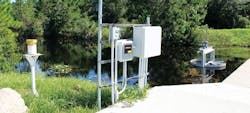About the author:
Lauryn Colquitt is marketing coordinator for Mission Communications. Colquitt can be reached at [email protected].
Florida has been directly struck by 110 hurricanes since 1851, making it the No. 1 state for hurricane hits. Some of the most damaging hurricanes in U.S. history have developed in the Gulf of Mexico because its warm ocean water makes it a prime area for hurricane formation. Like many cities in Florida, Palm Coast is no stranger to hurricanes and tropical storms. These storms endanger the water supply and the crews that have to prepare 54 miles of canals for heavy rainfall.
The storm water division of Palm Coast has plenty of tasks to complete in preparation for a hurricane. One of those tasks used to be removing stop logs from canal control structures. Removing the stop logs allowed the canals to drain, making room for the anticipated rainfall, but required crews to go out in dangerous conditions. In the past several years, Palm Coast has added electrically actuated gates on many structures as a means to control the canals remotely based on projected rainfall.
Room for Improvement
The city had been working on making improvements to its control structures over the past several years, and found an effective and economical solution: Mission Communications’ managed SCADA system.
Cellular-managed SCADA has demonstrated its resilience during natural disasters in the past. Cellular service providers are diligent about keeping cellular towers operational during times of emergency. Because most hurricane paths are forecast well in advance, cellular providers have time to prepare. Carriers prepare by pre-positioning crews and equipment for rapid deployment to repair damaged infrastructure. Cell towers frequently are equipped with backup power sources that enable them to continue operating until power is restored. When towers are damaged, carriers deploy cell sites on wheels to provisionally replace offline towers until they are repaired.
Because the cellular data channels have lower bandwidth requirements than voice, text (SMS) messages and e-mails are able to transmit during disruptions when voice is not. The Get Tech Ready Web resource from the Federal Emergency Management Agency (FEMA) recommends sending text messages during emergencies because they often have the ability to work in the event of a phone service disruption. While different from SMS, Mission SCADA has similar bandwidth requirements and utilizes the same cellular data networks for its service, making it reliable during mass calling events that occur during natural disasters. Alarms can be delivered via phone calls, text messages, e-mails, faxes and pagers. Utilizing multiple communication channels increases the chances of message retrieval in the event that one channel becomes congested.
Palm Coast’s Success Story
The city’s storm water utility has several remote terminal units (RTUs) and option boards on the control structures with the electrically actuated gates. The option board has two pulse inputs and two analog outputs. The pulse inputs measure pulses collected from rain tipping buckets, and the analog outputs offer variable control.
“Mission’s SCADA system allows us to monitor canal water levels and control the gates before, during and after tropical storms and hurricanes without putting Palm Coast crews at risk,” said Mike Brennan, storm water manager for the city of Palm Coast. Brennan uses the option board to operate the electrically actuated gates and monitor rainfall. The analog outputs remotely control the gates. The pulse inputs give Brennan rainfall data to compare with rising water levels. He uses this assessment to track the rate of change. Data collected from the rain tipping buckets notify decision makers of changing conditions in order to take corrective action if a storm changes direction.
“There have been a few instances where a tropical storm threatens the area, but changes direction at the last minute,” Brennan said. “By that time, we would have already removed the stop logs from the control structures to drain the canals in preparation for a storm that isn’t going to hit the city. Then we would be left with dry canals and residents complaining about the lack of water in the canals.”
Rainfall data let Brennan know when adjustments must be made. For example, if 2 to 3 in. of rain fall, he knows the gates need to be opened by a corresponding amount. If the storm switches direction, he is able to quickly close the gates to stop the flow of water.
“What used to take us three to four days now takes us a couple of minutes,” Brennan said. “We are able to control the water levels instantly without risking the safety of our employees.”
The elevation in Palm Coast ranges from sea level to 35 ft. The purpose-built storm water system mimics the original water table by holding back water with the surface water control structures. All the water formerly would drain off without the structures, leaving the wetland areas parched and reducing the amount of water stored in the city’s well fields. Ultimately, the hydraulic head on the groundwater table would decrease and allow saltwater to leach underneath the freshwater, eventually overpowering it. The system gives city officials the ability to closely monitor surface water levels within the canals and maintain a steady head pressure on the groundwater table.
“If water levels get too low, we are notified. This allows us to be proactive, rather than reactive,” Brennan said. The new option boards and RTUs offer Palm Coast officials complete oversight, even in inclement weather. The system saves the city time, money and water, and gives city crews the ability to efficiently prepare for a storm.
“When I need to change a gate position, I log into our Mission Web portal on my iPad. I make a few changes and that’s it,” Brennan said.
Brennan anticipates a substantial cost savings once every gate has an RTU. City officials plan to retrofit many more gates with the Mission SCADA system over the next few years.
Download: Here


